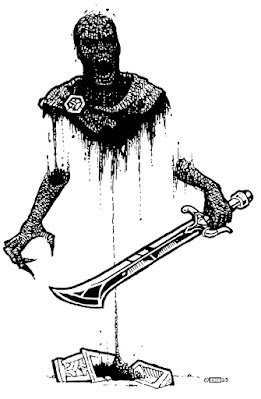They're still guilty pleasures, though, since their flaws are as great as their virtues. This is especially true in the case of the second module of the Desert of Desolation series, Oasis of the White Palm. Originally published in 1983, it's co-written by Hickman and Philip Meyers. I know nothing of Meyers, whose RPG credits are few – two AD&D modules (including this one) and a handful of articles in Dragon. As with Pharaoh, Jim Holloway provides the cover illustration, while Keith Parkinson takes care of the interior artwork.
Oasis of the White Palm picks up after the conclusion of Pharaoh, with the characters trudging across the desert. A hex map to facilitate this is provided, along with keyed and random encounters/events. Emphasis is placed on both encumbrance and the need for water during the characters' trek. From the vantage point of the present day, I find this interesting, since it runs counter to the expectation that a Hickman-penned adventure module is somehow not "old school" simply because it includes lots of boxed text and amateur dramatics. As I've noted before, Hickman's 1982–1983 modules are transitional ones that bridge the gap between the early days of the hobby and what would soon come. The Desert of Desolation modules all possess this quality.
The adventure proper begins once the characters stumble across the titular Oasis of the White Palm. The oasis serves as the camp of a group of nomads led by their sheik, Hassan Arslan. The nomads are somewhat suspicious of outsiders in light of recent events. The intended bride of the sheik's firstborn son has been kidnapped by servants of the Evil One – an efreeti noble who was freed during the events of Pharaoh. If the characters offer to help the sheik resolve this matter, he in turn offers the friendship of his people and a portion of his wealth. He also offers the aid of his second-born son as a guide through the desert, as they follow up on clues to where the bride might have been taken.
The oasis is filled with NPCs, many of whom provide rumors, opinions, and insight into the current situation. There are multiple factions and intrigues afoot, which goes a long way, I think, toward involving the characters in what's going on. This is useful, too, for the referee, who's looking to expand upon the basic scenario that Meyers and Hickman set forth. There's also some silliness, in the form of Happy Hogan's Desert Igloo, a halfling-owned bar in the middle of this pseudo-Bedouin community. The halfling, Hogan, is of course a retired adventurer whose exploits were once renowned. Silly though it definitely is, I cannot completely condemn its inclusion, since this is simply what fantasy RPGs were like back in the day – a chaotic goulash of the ridiculous and the sublime.
There are, in fact, two separate dungeons included in Oasis of the White Palm. The first, the Temple of Set, is a single-level affair. Nevertheless, it has some excellent tricks and traps of the sort one might expect in a pulp fantasy Egyptian tomb, complete with Grimtooth-style diagrams of their workings. The second, the Crypt of Badr Al-Mosak, has two levels and numerous diagrams to aid the referee in understanding how its various parts relate to one another. Though not quite The Caverns of Thracia by any means, elevation and position play roles in the Crypt, which I appreciate. The Crypt also includes one of my favorite traps, the Pits of Everfall, which looks like this:














